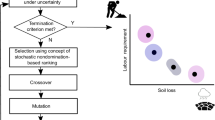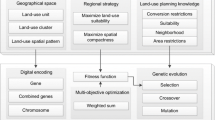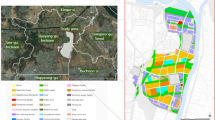Abstract
Soil erosion has become a pressing environmental concern worldwide. In addition to such natural factors as slope, rainfall, vegetation cover, and soil characteristics, land-use changes—a direct reflection of human activities—also exert a huge influence on soil erosion. In recent years, such dramatic changes, in conjunction with the increasing trend toward urbanization worldwide, have led to severe soil erosion. Against this backdrop, geographic information system-assisted research on the effects of land-use changes on soil erosion has become increasingly common, producing a number of meaningful results. In most of these studies, however, even when the spatial and temporal effects of land-use changes are evaluated, knowledge of how the resulting data can be used to formulate sound land-use plans is generally lacking. At the same time, land-use decisions are driven by social, environmental, and economic factors and thus cannot be made solely with the goal of controlling soil erosion. To address these issues, a genetic algorithm (GA)-based multi-objective optimization (MOO) approach has been proposed to find a balance among various land-use objectives, including soil erosion control, to achieve sound land-use plans. GA-based MOO offers decision-makers and land-use planners a set of Pareto-optimal solutions from which to choose. Shenzhen, a fast-developing Chinese city that has long suffered from severe soil erosion, is selected as a case study area to validate the efficacy of the GA-based MOO approach for controlling soil erosion. Based on the MOO results, three multiple land-use objectives are proposed for Shenzhen: (1) to minimize soil erosion, (2) to minimize the incompatibility of neighboring land-use types, and (3) to minimize the cost of changes to the status quo. In addition to these land-use objectives, several constraints are also defined: (1) the provision of sufficient built-up land to accommodate a growing population, (2) restrictions on the development of land with a steep slope, and (3) the protection of agricultural land. Three Pareto-optimal solutions are presented and analyzed for comparison. GA-based MOO is found able to solve the multi-objective land-use problem in Shenzhen by making a tradeoff among competing objectives. The outcome is alternative choices for decision-makers and planners.








Similar content being viewed by others
References
Abu Hammad A (2011) Watershed erosion risk assessment and management utilizing revised universal soil loss equation–geographic information systems in the Mediterranean environments. Water Environ J 25(2):149–162
Aerts JC, Eisinger E, Heuvelink G, Stewart TJ (2003) Using linear integer programming for multi‐site land‐use allocation. Geogr Anal 35(2):148–169
Balling R (2002) The maximin fitness function for multiobjective evolutionary optimization. Optimization in Industry, Springer 135–147
Balling R, Taber JT, Brown MR, Day K (1999) Multiobjective urban planning using genetic algorithm. J Urban Plan Dev 125(2):86–99
Balling R, Powell B, Saito M (2004) Generating future land‐use and transportation plans for high‐growth cities using a genetic algorithm. Comput Aided Civ Infrastruct Eng 19(3):213–222
Balling R, Wilson S (2001) The maxi-min fitness function for multi-objective evolutionary computation: application to city planning. Proceedings of the Genetic and Evolutionary Computation Conference (GECCO’2001)
Cai C, Ding S, Shi Z, Huang L, Zhang G (2000) Study of applying USLE and geographical information system IDRISI to predict soil erosion in small watershed. J Soil Water Conserv 14(2):19–24
Cao K, Batty M, Huang B, Liu Y, Yu L, Chen J (2011) Spatial multi-objective land use optimization: extensions to the non-dominated sorting genetic algorithm-II. Int J Geogr Inf Sci 25(12):1949–1969
Cao K, Huang B, Wang S, Lin H (2012) Sustainable land use optimization using boundary-based fast genetic algorithm. Comput Environ Urban Syst 36(3):257–269
Chen DY, Yang DS, Xiao WG, Wu CW (2001) Application of SPOT remote sensing data to the survey of soil erosion status in Shenzhen. Pearl River 22(05):55–57
Chen Z, Gong C, Wu J, Yu S (2012) The influence of socioeconomic and topographic factors on nocturnal urban heat islands: a case study in Shenzhen, China. Int J Remote Sens 33(12):3834–3849
Dumas P, Printemps J, Mangeas M, Luneau G (2010) Developing erosion models for integrated coastal zone management: a case study of The New Caledonia west coast. Mar Pollut Bull 61(7):519–529
Fistikoglu O, Harmancioglu NB (2002) Integration of GIS with USLE in assessment of soil erosion. Water Resour Manag 16(6):447–467
Guldmann J-M (1979) Urban land use allocation and environmental pollution control: an intertemporal optimization approach. Socio Econ Plan Sci 13(2):71–86
Hajela P, Lin C-Y (1992) Genetic search strategies in multicriterion optimal design. Struct Optim 4(2):99–107
Holzkämper A, Seppelt R (2007) A generic tool for optimising land-use patterns and landscape structures. Environ Model Software 22(12):1801–1804
Hopkins L (1977) Land-use plan design—quadratic assignment and central-facility models. Environ Plan A 9(6):625–642
Kim JB, Saunders P, Finn JT (2005) Rapid assessment of soil erosion in the Rio Lempa Basin, Central America, using the universal soil loss equation and geographic information systems. Environ Manag 36(6):872–885
Konak A, Coit DW, Smith AE (2006) Multi-objective optimization using genetic algorithms: a tutorial. Reliab Eng Syst Saf 91(9):992–1007
Kumar S, Kushwaha S (2013) Modeling soil erosion risk based on RUSLE-3D using GIS in a Shivalik sub-watershed. J Earth Syst Sci 1–10
Lal R (1995) Global soil erosion by water and carbon dynamics. Soils Glob Chang 131–142
Lal R, Bruce J (1999) The potential of world cropland soils to sequester C and mitigate the greenhouse effect. Environ Sci Pol 2(2):177–185
Lee S (2004) Soil erosion assessment and its verification using the universal soil loss equation and geographic information system: a case study at Boun, Korea. Environ Geol 45(4):457–465
Li JJ, Wang YL, Li DQ, Zhuo ML, Wu JS (2013) Characterization and evaluation of agricultural soil erosion in Shenzhen City using environmental radionuclides. Res Environ Sci 26(7):780–786
Li T, Li W, Qian Z (2010) Variations in ecosystem service value in response to land use changes in Shenzhen. Ecol Econ 69(7):1427–1435
Li Y, Liu C, Yuan X (2009) Spatiotemporal features of soil and water loss in three gorges reservoir area of Chongqing. J Geogr Sci 19(1):81–94
Ligmann-Zielinska A, Church R, Jankowski P (2005) Sustainable urban land use allocation with spatial optimization. Conference Proceedings. The 8th International Conference on Geocomputation
Ligmann-Zielinska A, Church RL, Jankowski P (2008) Spatial optimization as a generative technique for sustainable multiobjective land-use allocation. Int J Geogr Inf Sci 22(6):601–622
Los M (1978) Simultaneous optimization of land-use and transportation—synthesis of quadratic assignment problem and optimal network problem. Reg Sci Urban Econ 8(1):21–42
Lufafa A, Tenywa M, Isabirye M, Majaliwa M, Woomer P (2003) Prediction of soil erosion in a Lake Victoria basin catchment using a GIS-based universal soil loss model. Agric Syst 76(3):883–894
Ma CF, Ma JW, Buhe-Aosaier (2001) Quantitative assessment of vegetation coverage factor in USLE model using remote sensing data. Bull Soil Water Conserv 21(4):6–9
McCool D, Brown L, Foster G, Mutchler C, Meyer L (1987) Revised slope steepness factor for the Universal soil loss equation. American Society of Agricultural Engineers, Transactions TAAEAJ 30(5)
Meusburger K, Konz N, Schaub M, Alewell C (2010) Soil erosion modelled with USLE and PESERA using QuickBird derived vegetation parameters in an alpine catchment. Int J Appl Earth Obs Geoinf 12(3):208–215
Meyer WB, Turner BL II (1994) Changes in land use and land cover: a global perspective. Cambridge University Press, Cambridge
Mu TL, Xie J, Wu JS, Wang XR, Zheng MK (2010) Effects of land use on soil erosion in Shenzhen, China. Res Soil Water Conserv 3:012
Nachtergaele F, Van Velthuizen H, Verelst L (2008) Harmonized world soil database. Food and Agriculture Organization of the United Nations
Ning S-K, Chang N-B, Jeng K-Y, Tseng Y-H (2006) Soil erosion and non-point source pollution impacts assessment with the aid of multi-temporal remote sensing images. J Environ Manag 79(1):88–101
Oh J, Jung S (2005) Potential soil prediction for land resource management in the Nakdong River basin. J Korea Soc Rural Plan 11(2):9–19
Ozcan AU, Erpul G, Basaran M, Erdogan HE (2008) Use of USLE/GIS technology integrated with geostatistics to assess soil erosion risk in different land uses of Indagi Mountain Pass—Cankırı, Turkey. Environ Geol 53(8):1731–1741
Ozsoy G, Aksoy E, Dirim MS, Tumsavas Z (2012) Determination of soil erosion risk in the Mustafakemalpasa River Basin, Turkey, using the revised universal soil loss equation, geographic information system, and remote sensing. Environ Manag 50(4):679–694
Park S, Oh C, Jeon S, Jung H, Choi C (2011) Soil erosion risk in Korean watersheds, assessed using the revised universal soil loss equation. J Hydrol 399(3–4):263–273
Pimentel D (1993) World soil erosion and conservation. Cambridge University Press, Cambridge
Pimentel D, Harvey C, Resosudarmo P, Sinclair K, Kurz D, McNair M, Crist S, Shpritz L, Fitton L, Saffouri R (1995) Environmental and economic costs of soil erosion and conservation benefits. Science-New York Then Washington 1117–1117
Sharpley A N, Williams J R (1990) EPIC-erosion/productivity impact calculator: 1. Model documentation. Technical Bulletin-United States Department of Agriculture (1768 Pt 1)
SL190-2007 (2008) Standards for classification and gradation of soil erosion. M. o. w. r. o. t. p. s. R. o. China
Shenzhen Statistics Bureau (1997) Shenzhen statistic yearbook. China Statistics Press, Beijing
Shenzhen Statistics Bureau (2001) Shenzhen statistic yearbook. China Statistics Press, Beijing
Shenzhen Statistics Bureau (2003) Shenzhen statistic yearbook. China Statistics Press, Beijing
Shenzhen Statistics Bureau (2005) Shenzhen statistic yearbook. China Statistics Press, Beijing
Shenzhen Statistics Bureau (2007) Shenzhen statistic yearbook. China Statistics Press, Beijing
Shenzhen Statistics Bureau (2009) Shenzhen statistic yearbook. China Statistics Press, Beijing
Stewart TJ, Janssen R, van Herwijnen M (2004) A genetic algorithm approach to multiobjective land use planning. Comput Oper Res 31(14):2293–2313
Tsyganok VV, Kadenko SV, Andriichuk OV (2012) Significance of expert competence consideration in group decision making using AHP. Int J Prod Res 50(17):4785–4792
Van Hengstum P, Reinhardt E, Boyce J, Clark C (2007) Changing sedimentation patterns due to historical land-use change in Frenchman’s Bay, Pickering, Canada: evidence from high-resolution textural analysis. J Paleolimnol 37(4):603–618
Wang Z, Bai Z, Yu H, Zhang J, Zhu T (2004) Regulatory standards related to building energy conservation and indoor-air-quality during rapid urbanization in China. Energy Build 36(12):1299–1308
Wischmeier WH (1976) Use and misuse of universal soil loss equation. J Soil Water Conserv 31(1):5–9
Wischmeier W H, Smith D D (1961) A universal equation for predicting rainfall erosion losses—an aid to conservation farming in humid regions. US Dept. of Agric., Agr. Res. Serv. ARS Special Report 22–66
Wischmeier W H, Smith D D (1978) Predicting rainfall erosion losses—a guide to conservation planning.
Wu L, Long T-Y, Cooper WJ (2012) Temporal and spatial simulation of adsorbed nitrogen and phosphorus nonpoint source pollution load in Xiaojiang watershed of three gorges reservoir area, China. Environ Eng Sci 29(4):238–247
Xu Y, Li T (1999) Dynamic evaluation of soil erosion in Shenzhen based on land-use structural variation. J Yangtze River Sci Res Inst 26(7):6–12
Yang D, Kanae S, Oki T, Koike T, Musiake K (2003) Global potential soil erosion with reference to land use and climate changes. Hydrol Process 17(14):2913–2928
Zhang H, Zeng Y, Bian L (2010) Simulating multi-objective spatial optimization allocation of land use based on the integration of multi-agent system and genetic algorithm. Int J Environ Res 4(4):765–776
Zhao YX, Zhang WS, Wang Y, Wang TT (2007) Soil erosion intensity prediction based on 3S technology and the USLE: a case from Qiankeng Reservoir Basin in Shenzhen [J]. J Subtrop Resour Environ 3:006
Zhou W, Xie S, Zhu L, Tian Y, Yi J (2008) Evaluation of soil erosion risk in Karst regions of Chongqing, China. Opt Eng Appl 70831E-70831E-70810
Author information
Authors and Affiliations
Corresponding author
Additional information
Responsible editor: Michael Matthies
Rights and permissions
About this article
Cite this article
Zhang, W., Huang, B. Soil erosion evaluation in a rapidly urbanizing city (Shenzhen, China) and implementation of spatial land-use optimization. Environ Sci Pollut Res 22, 4475–4490 (2015). https://doi.org/10.1007/s11356-014-3454-y
Received:
Accepted:
Published:
Issue Date:
DOI: https://doi.org/10.1007/s11356-014-3454-y




